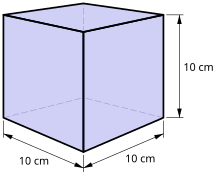A litre (international spelling) or liter (American spelling) is one of the metric units of volume. It is not a basic SI unit, but it is a supplementary unit.
| Litre | |
|---|---|
 One litre is the volume of a cube with 10 cm sides | |
| General information | |
| Unit system | Non-SI unit accepted for use with SI |
| Unit of | Volume |
| Symbol | l[1] or L[1] |
| In SI base units: | 1 l = 10−3 m3 |
One litre is the volume of 1000 cubic centimetres, that is a cube of 10 × 10 × 10 centimetres (1000 cm3). One litre of water at 4 °C (277 K; 39 °F) has the mass of exactly one kilogram. This results from the definition given in 1795, where the gram was defined as the weight of one cubic centimetre of melting ice.[2]
Liters are usually utilized to measure the volume of liquids, this is because the density of liquids can vary a lot. However it can be applied to solids as well, for example 1 liter of Iron is around 7.7 kg. The symbol for litre is l or L.[1] The script letter ℓ is also sometimes used.
For smaller volumes, the decilitre is used: 10 decilitres = one litre.
For smaller volumes, the centilitre is used: 100 centilitres = one litre.
For smaller volumes, the millilitre is used: 1000 millilitres = one litre.
The capital letter "L" is preferred by some people as the small "l" can look like the number one "1".
History
changeThe metric system was first introduced in France in 1791.[3][4] That system did not have its own unit of capacity or volume because volume can be measured in cubic metres.[4] In 1793 work to make the metric system compulsory in France was started by the Temporary Commission of Republican Weights and Measures. Due to public demand,[4] the commission said that the cubic metre was too big for everyday use. They said that a new unit based on the old cadil should be used instead. One cadil was to be 0.001 cubic metres. This was equivalent to a cube with sides 10 cm.[5] The cadil was also known as the pinte or the litron. The pinte had been an old French unit of measure of capacity.[4] In 1795 the definition was revised. The cadil was given the name litre.[6]
In 1795 the kilogram was defined to be exactly one litre of water at 4 °C. In 1799 the kilogram was redefined. The new definition said that the kilogram was the mass of the kilogram des archives. In 1901 scientists measured the volume of one litre of water at 4 °C very carefully.[Note 1] They found that it occupied about 1.000028 dm3.[7] The BIPM redefined the litre as being exactly the volume of one kilogram of water at 4 °C.[8]
In 1960 the SI was introduced. The BIPM changed the definition of the litre back to "one dm3". The litre is not part of SI. The BIPM defined the litre[Note 2] as a "Non-SI unit accepted for use with the SI". This was because it is used in many countries. The BIPM said that the litre should not be used for very accurate work.[9][10]
According to SI rules, the symbol for the litre should be "l". This is because the litre was not named after somebody whose name was "Litre".[Note 3] However the symbol "l" and the number "1" are easily confused. In 1979 the BIPM made an exception for the symbol for the litre. They said that people could use either "L" or "l" as its symbol.[11]
In Europe, milk is sold in one litre cartons. One litre bottle is also a popular package for soft drinks. Most alcoholic drinks are sold as 1/3 litre (0.33 l), 1⁄2 litre (0.5 l) 3/4 litre (0.75 l) or 1 litre bottles.
Notes
changeReferences
change- ↑ 1.0 1.1 1.2 International Bureau of Weights and Measures (2006), The International System of Units (SI) (PDF) (8th ed.), p. 124, ISBN 92-822-2213-6
- ↑
"Decree on weights and measures". 7 April 1795.
Gramme, le poids absolu d'un volume d'eau pure égal au cube de la centième partie du mètre, et à la température de la glace fondante.
English translation: "Gramme: the absolute weight of a volume of pure water equal to the cube of the hundredth part of the meter, at the temperature of melting ice." - ↑ Uvarov, E.B.; Isaacs, Alan (1986). The Penguin Dictionary of Science. Penguin Books. ISBN 978-0-14-051156-7.
- ↑ 4.0 4.1 4.2 4.3 Fenna, Donald (2002). Oxford Dictionary of Weights, Measures and Units. Oxford University Press. litre,liter. ISBN 978-0-19-860522-5.
- ↑ Instruction sur les mesures déduites de la grandeur de la terre, uniformes pour toute la république, et sur les calculs relatifs a leur division décimale [Use of measures that are uniform throughout the republic and that are derived from the size of the earth and calculations relating to their decimal division] (in French). Paris: Commission temporaire des Poids et Mesures républicaines. April 1793. pp. 44–49.
- ↑ Hellman, C. Doris (Jan 1936). "Legendre and the French Reform of Weights and Measures". Orsis. 1. University of Chicago: 314–340. JSTOR 301613.
- ↑ Thompson, Ambler; Taylor, Barry N. (2008). "Guide for the Use of the International System of Units (SI)" (PDF). Gaithersburg: National Institute of Standards and Technology. p. 51. SP 911.
- ↑ "Resolution of the 3rd meeting of the CGPM (1901)". BIPM. Retrieved 5 March 2014.
- ↑ "Resolution 6 of the 12th meeting of the CGPM (1964)". BIPM. Retrieved 5 March 2014.
- ↑ International Bureau of Weights and Measures (2006), The International System of Units (SI) (PDF) (8th ed.), p. 124, ISBN 92-822-2213-6
- ↑ "Resolution 6 of the 16th meeting of the CGPM (1979)". BIPM. Retrieved 5 March 2014.